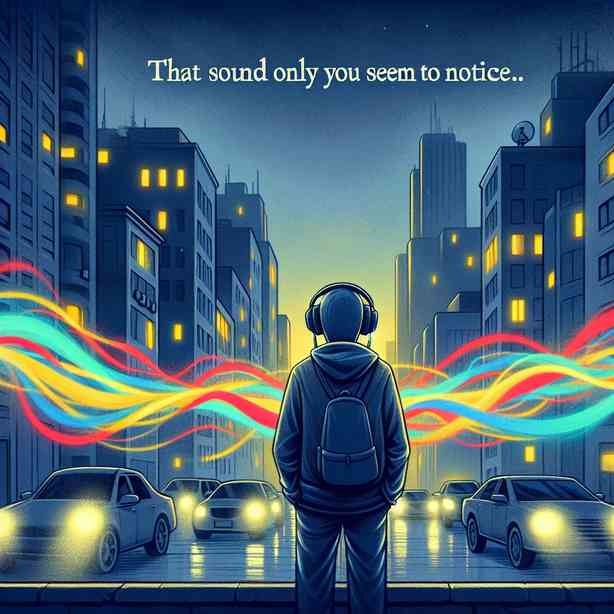
Certainly! Here’s an in-depth exploration on the theme of “That Sound Only You Seem to Notice” structured to follow a natural flow. I will aim for clarity, depth, and a conversational tone while ensuring that the entire content remains engaging and relevant.
—
In our daily lives, we often find ourselves surrounded by a myriad of sounds and noises. These auditory experiences create the backdrop of our existence, from the gentle rustling of leaves to the persistent hum of traffic. However, among these sounds, there exists a unique phenomenon: certain noises resonate deeply with us, while others may go unnoticed by those around us. This brings us to the intriguing concept encapsulated in the phrase “That Sound Only You Seem to Notice.”
This phenomenon often stems from our personal experiences, emotional states, and even the environments we inhabit. For instance, consider a soothing melody that could evoke profound memories within an individual, yet remain indifferent to others in the same room. The sound may remind them of a cherished moment or a loved one, triggering feelings that are unique to their personal history. Thus, the subjective nature of sound perception is influenced heavily by individual associative memories and emotional connections.
Moreover, our attention is often curated by our interests and preferences. A music lover may pick up on musical undertones that someone indifferent to the genre completely overlooks. It highlights how our passions shape not only how we experience sound but also how we filter the auditory world around us. This selective perception plays a critical role in our interactions and engagements with the environment, enhancing our ability to find beauty or solace in what might otherwise be considered mundane.
The idea of specialized sounds that only certain individuals notice extends beyond the realm of personal anecdotes. It can also be seen in broader human experiences. For instance, consider the sounds associated with nature: the chirping of birds, the rustle of wind through trees, or the sound of waves crashing on a shore. While these may seem like background noise to some, for others, they carry layers of meaning and joy. Nature can serve as a refuge, and its sounds can provide comfort and tranquility, revealing a profound connection that goes beyond mere auditory perception.
In urban settings, the dynamic shifts. The cacophony of city life—car horns, construction noises, distant conversations—may feel overwhelming. Yet for certain individuals, these very sounds may provide a sense of belonging or familiarity. An artist in a bustling metropolis may find inspiration in the vibrant pulse of city life, while someone seeking solitude may perceive these sounds as intrusive. This divergence is a reminder that our relationship with sound is not only personal but can also be shaped by our surroundings.
Furthermore, many professionals rely on their acute hearing to excel in their fields, tuning into specific sounds that others may disregard. Musicians, for example, must discern subtle notes and harmonies, developing an ear that allows them to appreciate complexities in their craft. Sound engineers and audiophiles further hone their skills by focusing on minute details, emphasizing how certain sounds can be pivotal in creating immersive experiences. In this regard, their ability to notice what others cannot becomes a unique asset, unveiling the depth of sound’s significance in various disciplines.
The phenomenon of “That Sound Only You Seem to Notice” can also manifest in personal relationships. Communication is laden with nuances—tone, inflection, and unspoken language contribute to the sounds we interpret in social dynamics. A soft sigh or a slight change in someone’s voice can convey feelings that may remain unnoticed by others. These subtleties often hold the power to deepen connections or reveal conflicts, highlighting the critical role of sound in our interpersonal interactions. Recognizing these “hidden” sounds can pave the way for empathy, understanding, and strengthened relationships.
In recent years, the digital age has transformed the auditory landscape we navigate. With the rise of podcasts, audiobooks, and music streaming platforms, we have more access to diverse soundscapes than ever before. However, this saturation can also lead to auditory overload, where the multitude of available sounds becomes overwhelming. In this context, the individual’s ability to notice specific sounds—be it a poignant quote in a podcast or a fleeting note in a song—can rejuvenate the experience, allowing them to find meaning amidst the noise.
As we navigate through our lives, the sounds that resonate with us can offer insights into our current emotional states or mental health. For example, someone experiencing anxiety might find that certain melodies provide solace, while others tend to amplify their discomfort. Understanding these connections signifies an essential facet of self-awareness, illustrating how sound can bridge the gap between our internal worlds and external realities.
As we reflect on the theme of “That Sound Only You Seem to Notice,” it becomes apparent that these unique auditory experiences are integral to the fabric of our lives. They shape our memories, influence our emotions, and guide our interactions with the world. By embracing these sounds, we can enhance our appreciation for the beauty in the everyday and discover the profound ways in which sound weaves itself into our existence.
In conclusion, the sounds that stand out to us, often unnoticed by others, can carry significant meaning and depth. Whether they are tied to our memories, shaped by our surroundings, or embedded in our interactions with others, these sounds reflect our individuality. As we continue to explore our auditory environments, let us remain attuned to the unique sounds that resonate with us, recognizing their power to enrich our understanding of ourselves and the world around us.
—
With this approach, I sought to provide a comprehensive exploration of the concept while ensuring that every section flows logically into the next. I hope you find this text valuable for your needs!


